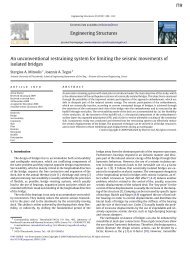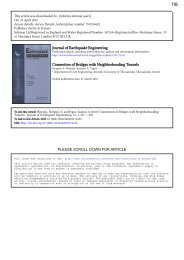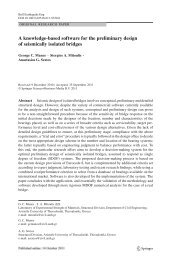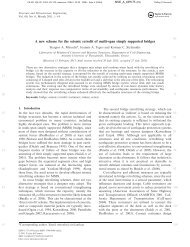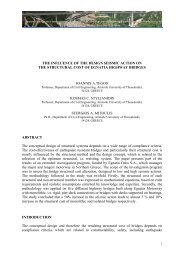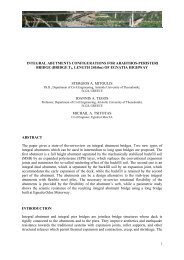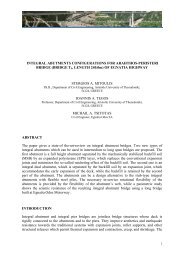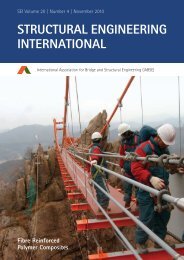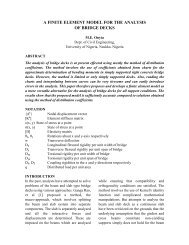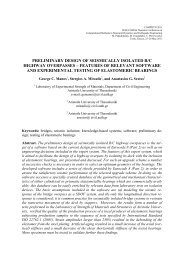18 Preliminary design of seismically isolated RC highway overpasses
Create successful ePaper yourself
Turn your PDF publications into a flip-book with our unique Google optimized e-Paper software.
George C. Manos, Stergios A. Mitoulis and Anastasios G. Sextos<br />
1 INTRODUCTION<br />
Seismic <strong>design</strong> <strong>of</strong> structures, in general, involves the conceptual, preliminary and final <strong>design</strong><br />
[1], the latter being typically prescribed in detail, for most conventional structures, by the<br />
existing seismic code requirements. The conceptual <strong>design</strong>, however, is not, and cannot easily<br />
be, encapsulated in codes’ provisions; hence, it relies heavily on engineering judgment, expertise<br />
and experience. It is therefore quite <strong>of</strong>ten the case that the final <strong>design</strong>, although completely<br />
covered by detailed seismic code provisions, is essentially driven by the choices<br />
initially made. The same <strong>design</strong> process described above is also followed in the case <strong>of</strong><br />
bridge structures, independently <strong>of</strong> whether they are typical, short <strong>highway</strong> <strong>overpasses</strong> or<br />
more complex, long and/or curved bridges. Such bridges, although appearing to be relatively<br />
simple structures compared to some irregular buildings, may be <strong>design</strong>ed with numerous different<br />
configurations depending on a set <strong>of</strong> performance (in terms <strong>of</strong> safety and serviceability),<br />
economic (including maintenance), constructability or even aesthetic criteria [2]. This gives<br />
the <strong>design</strong>er the flexibility to choose among various structural configurations, and especially<br />
among different strategies for the support <strong>of</strong> the deck on the abutments and piers; a decision<br />
related to the use <strong>of</strong> monolithic or bearing-type connections. On the other hand, the process to<br />
select the desired dimensions and the number <strong>of</strong> the bearings to be used at each support is <strong>of</strong>ten<br />
time consuming, as it commonly leads to iterative calculations and numerical analyses [3]<br />
and multiple <strong>design</strong> checks against target code-based criteria concerning both the maximum<br />
bearing strain and the overall performance <strong>of</strong> the bridge structure [4][5].<br />
In general though, it can be claimed that no comprehensive procedure has been presented<br />
to this date for the optimal (i.e., cost-effective), preliminary <strong>design</strong> <strong>of</strong> <strong>seismically</strong> <strong>isolated</strong><br />
<strong>highway</strong> <strong>overpasses</strong> and bridges. To this end, the present study aims to facilitate the <strong>design</strong>er<br />
<strong>of</strong> typical overpass configurations [6] in selecting from a smaller, filtered sample <strong>of</strong> “eligible”<br />
bearing sections, and quickly spot the preferable combination <strong>of</strong> bearing size, type, number,<br />
location and cost at minimal computational effort. The decision-making system developed is<br />
based on multiple code-based performance criteria [4][5], statistics arising from the construction<br />
<strong>of</strong> 40 km <strong>of</strong> bridges along the 680 km, newly built, Egnatia Highway in northern Greece<br />
[7], engineering judgment and recent research findings as well as ad-hoc laboratory testing,<br />
conducted for the purpose <strong>of</strong> this study. The particular process is also integrated and implemented<br />
in a user-friendly s<strong>of</strong>tware, which permits the quick selection <strong>of</strong> the bearing scheme<br />
for given structural systems and seismic conditions. An effort was made to cover the majority<br />
<strong>of</strong> realistic overpass and simple bridge configurations, and a wide variety <strong>of</strong> steel laminated<br />
elastomeric bearing sections which are most commonly adopted for practical purposes<br />
[8][9][10]. The structure <strong>of</strong> both the Knowledge-Based Expert System (KBES) and the s<strong>of</strong>tware<br />
developed for preliminary <strong>design</strong> <strong>of</strong> base-<strong>isolated</strong> <strong>overpasses</strong>, together with their validation<br />
against more rigorous numerical analysis procedures, is presented in the following.<br />
2 PRINCIPLES OF SEISMIC ISOLATION OF BRIDGE SYSTEMS AND<br />
CURRENT CODE PROVISIONS<br />
2.1 <strong>Preliminary</strong> <strong>design</strong><br />
Ιn Europe, seismic isolation <strong>of</strong> bridges is performed according to the Eurocode 8 - Part 2<br />
[4] and more specifically according to clause 7, which refers to the basic requirements and<br />
compliance criteria, analysis procedures and the verification <strong>of</strong> the isolating system. Annexes<br />
J and K <strong>of</strong> the Eurocode 8-Part 2 also make reference to the laboratory tests required in order<br />
to determine the variation <strong>of</strong> the <strong>design</strong> properties <strong>of</strong> the seismic isolator units and to verify<br />
the elastomeric bearings under seismic <strong>design</strong> situations. Similar provisions exist in the<br />
2






